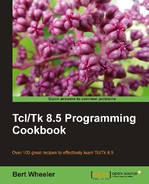Regular expressions provide us with a powerful method to locate an arbitrarily complex pattern within a string. The regexp command is similar to a Find function in a text editor. You search for a defined string for the character or the pattern of characters you are looking for and it returns a Boolean value that indicates success or failure and populates a list of optional variables with any matched strings. The -indices and -inline options must be used to modify the behavior, as indicated by this statement. But it doesn't stop there; by providing switches, you can control the behavior of regexp. The switches are as follows:
|
Switch |
Behavior |
|---|---|
|
|
No actual matching is made. Instead |
|
|
Allows the use of expanded regular expression, wherein whitespaces and comments are ignored. |
|
|
Returns a list of two decimal strings, containing the indices in the string to match for the first and last characters in the range. |
|
|
Enables the newline-sensitive matching similar to passing the |
|
|
Changes the behavior of [^] bracket expressions and the "." character so that they stop at newline characters. |
|
|
Changes the behavior of ^ and $ (anchors) so that they match both the beginning and end of a line. |
|
|
Treats uppercase characters in the search string as lowercase. |
|
|
Causes the command to match as many times as possible and returns the count of the matches found. |
|
|
Causes Match variables may NOT be used if |
|
|
Allows us to specify a character index from which searching should start. |
|
|
Denotes the end of switches being passed to Any argument following this switch will be treated as an expression, even if they start with a "-". |
Now that we have a background in switches, let's look at the command:
regexp switches expression string submatchvar submatchvar…
The regexp command determines if the expression matches part or all of the string and returns a 1 if the match exists or a 0 if it is not found. If the variables (submatchvar) (for example myNumber or myData) are passed after the string, they are used as variables to store the returned submatchvar. Keep in mind that if the inline switch has been passed, no return variables should be included in the command.
To complete the following example, we will need to create a Tcl script file in your working directory. Open the text editor of your choice and follow the next set of instructions.
A common use for regexp is to accept a string containing multiple words and to split it into its constituent parts. In the following example, we will create a string containing an IP address and assign the values to the named variables. Enter the following command:
% regexp "([0-9]{1,3}).([0-9]{1,3}).([0-9]{1,3}).([0-9]{1,3})"
$ip all first second third fourth
% puts "$all
$first
$second
$third
$fourth"
192.168.1.65
192
168
1
65
As you can see, the IP Address has been split into its individual octet values. What regexp has done is match the groupings of decimal characters [0-9] of a varying length of 1 to 3 characters {1, 3} delimited by a "." character. The original IP address is assigned to the first variable (all) while the octet values are assigned to the remaining variables (first, second, third, and fourth).
